- Albanian
- Arabic
- Belarusian
- Bengali
- Czech
- English
- French
- German
- Hebrew
- Hungarian
- Indonesian
- irish
- Italian
- Japanese
- kazakh
- Persian
- Russian
- Thai
- Uzbek
- Vietnamese
types of roller coasters
Types of Roller Coasters
Roller coasters are one of the most exhilarating and popular attractions found in amusement parks worldwide. They combine speed, height, and sharp curves to provide riders with a thrilling experience. With advancements in technology and innovative designs, various types of roller coasters have been developed over the years, each offering a unique way to experience the thrill of speed and gravity. In this article, we will explore some of the most popular types of roller coasters.
1. Wooden Roller Coasters
Wooden roller coasters are among the oldest types of coasters, with their origins dating back to the late 19th century. Constructed primarily from wood, these coasters offer a nostalgic feel and a classic ride experience. They are known for their steeper drops, sudden turns, and the unique rattle that comes with wooden construction. Famous examples include the Coaster at Cedar Point and the Thunderhead at Dollywood. Riding a wooden coaster can evoke feelings of nostalgia and excitement as riders traverse their winding tracks.
2. Steel Roller Coasters
Steel roller coasters have dramatically changed the landscape of amusement parks since their introduction in the 1970s. These coasters are constructed from steel tracks, allowing for smoother rides and more complex designs. Steel coasters can reach higher speeds and steeper drops compared to wooden coasters. Some popular steel roller coasters include Millennium Force at Cedar Point and Steel Vengeance, which features inversions, loops, and zero-gravity rolls, showcasing the cutting-edge engineering that modern technology allows.
Inverted roller coasters provide a unique experience where riders sit below the track, with their feet dangling in the air. This design creates a sense of weightlessness and allows for thrilling loops and corkscrews. Riders experience rapid transitions from upside-down to right-side-up, generating an exhilarating feeling. Iconic inverted coasters such as Batman The Ride and Kumba offer riders a different perspective on the traditional coaster experience.
types of roller coasters

4. Launch Coasters
Launch coasters are characterized by their unique start mechanism; instead of a traditional lift hill, they use linear synchronous motors or other technologies to propel riders forward quickly. This allows for rapid acceleration, often reaching top speeds in just a few seconds. Notable examples include Kingda Ka, which is one of the tallest and fastest coasters in the world, and Top Thrill Dragster, known for its thrilling launch and vertical drops.
5. Dive Coasters
Dive coasters are another exciting type of roller coaster that features a vertical drop, often with a sudden pause at the top to build anticipation before plummeting downward. This nerve-racking experience can be both terrifying and thrilling, as riders plunge at steep angles. Griffon at Busch Gardens Williamsburg and Shieko at Six Flags Over Texas are popular examples, and they give riders an adrenaline rush unlike any other.
6. Spinning Coasters
Spinning coasters involve the cars rotating on their axis as they navigate the tracks, adding an additional layer of thrill and unpredictability to the ride. This movement can enhance sensations of speed and disorientation, as riders twist and turn. Tornado at the World Joyland Amusement Park is known for its unpredictable spins and unique ride experience.
Conclusion
The world of roller coasters is diverse and continually evolving, offering something for everyone—from the nostalgic appeal of wooden coasters to the high-speed thrills of steel and launch coasters. Each type of roller coaster provides a unique experience, catering to different preferences and thrill levels. Whether you enjoy the classic rattle of wooden coasters or the futuristic feel of inverted and spinning coasters, these attractions guarantee an adrenaline rush and unforgettable memories. With parks and designers constantly innovating, the future of roller coasters promises even more breathtaking experiences for thrill-seekers everywhere.
-
Flume Ride: Thrilling Water-Based Adventure | Hebei Zhipao Amusement Equipment Manufacturing Co., Ltd.Aug.01,2025
-
Flume Ride-Hebei Zhipao Amusement Equipment Manufacturing Co., Ltd.|Thrilling Water Attraction&NIST Safety StandardsAug.01,2025
-
Double Ferris Wheel Sale | Premium Custom RidesJul.31,2025
-
Flume Ride-Hebei Zhipao|Water-Based Attraction, Safety Standards, High-Speed DescentJul.31,2025
-
Flume Ride: Thrilling Water-Based Adventure & Advanced Engineering - Hebei ZhipaoJul.31,2025
-
Flume Ride-Hebei Zhipao Amusement Equipment Manufacturing Co., Ltd.|Thrilling Water Attraction&Customizable DesignJul.30,2025
